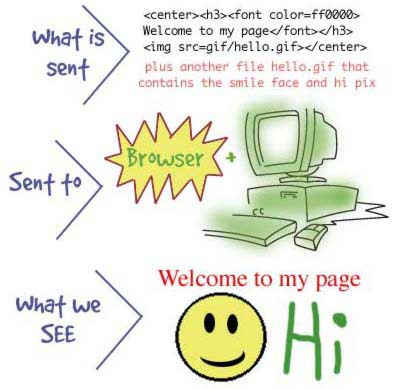|
|
Question: What is a Browser? |
|
Answer: A browser (short for web browser) is a computer program (software) that accesses web pages and displays them on your computer screen. |
If you are reading this on a computer - you are probably using a browser! The browser is a client program that is reading files from a web server. The browser sends a request to the server for a specific web page - receives the information in small pieces of information - interprets special commands that format the information and displays the web page. These commands are HTML (Hyper Text Markup Language).
This page Internet Basics 101 - Browser is actually using 5 different files. The text that you see in this section is from a plain text file. The bold, larger font sizes, pictures etc. are read and interpreted by your browser. Each of the graphics are in a separate file.

It is the browsers job to interpret the HTML, find all the pictures (or other types of media), take all of these pieces and display the information. Browsers are capable of accepting text, pictures, sound, and movies. Browsers use "helper applications" to generate some of these special effects. Quicktime is an example of this: Quicktime is a program and a plug-in that allows playing movies through your browser. Plug-ins add a patch to the browser that looks for these helper applications. Sometimes you must configure your browser to handle these different plug-ins.
Question: What are some browsers that are available?
- Answer: The two main browsers available are Netscape and Internet Explorer.
Question: I've heard someone talk about Linux as a web browser. What is Linux?
- Answer: Linux is a text-based browser. Most people are not too
interested in this format
because it lacks the graphical interface.
Question: Why does it have to be done this way?
- Answer: Well, everything sent through the modem is sent in a
text only format. That means that the font size, font style, formatting, etc. have to be
entered into a format that everyone on the web can read. So, instead of drawing the page
and sending all of that information, it sends all of the information and lets the viewers
computer interpret how to display that information. By sending the information this way
it reduces the transmission time for both computer.
14179
|
|
Back to Internet 101 |